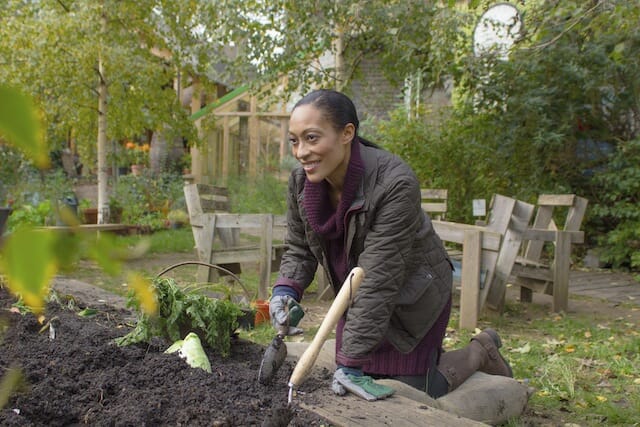
Spreading Compost and Other October Gardening Tips
Charlie Nardozzi, Horticulturist and
Leonard Perry, UVM Extension Horticulturist
 Spreading compost, adding soil amendments, and planting garlic now for harvest next July are some of the gardening activities for this month.
Spreading compost, adding soil amendments, and planting garlic now for harvest next July are some of the gardening activities for this month.
As you empty annual beds this fall, there are two main ways to enrich the soil for next year: spreading compost or planting cover crops. While this month is a bit late to sow cover crops, you can apply compost. Before you spread compost, dig or lightly till in any plants that aren’t diseased to return nutrients to the soil. Spread compost, even if it’s not well decomposed yet. It will protect the soil over the winter and break down by spring planting time.
If you need to raise or lower the pH (soil acidity) of your soil, add the required amendments, such as sulfur (to lower pH) or lime (to raise pH), this fall because they take some time to work. This is important to test every few years, or particularly if you’re preparing a new site, as without the proper pH nutrients won’t be available to plants.
Take soil samples from different parts of your yard and garden and test them separately so you can apply what’s needed for each particular use. Extension test kits are available from local offices and some garden stores. Simple home test kits are available at some garden stores, but they are much less accurate than those from state university labs, especially if they’re old.
Plant garlic now for harvesting next summer. Purchase garlic sold specifically for planting, or buy organic garlic. Commercial, nonorganic, supermarket garlic may have been treated to inhibit sprouting. Break the garlic head into individual cloves, keeping the largest ones for planting. (Use the small cloves for cooking.) Plant cloves with the pointed side up about 3 inches apart in rows, with rows about 6 inches apart, Try some different varieties to see which you prefer. Mulch the bed well with straw.
Keep leaves raked from lawns so they don’t smother the grass. Mow until the grass stops growing, often early to the middle of the month. With the last mowing you can mow a bit lower if you’ve been mowing higher as is proper—2 to 3 inches instead of 3 to 4 inches. This helps prevent grass from ending up too tall in the spring, susceptible to disease such as snow mold. Spread a thin topping of compost on the lawn after you rake up leaves, and rake again to settle the compost.
Buy some bulbs for “forcing”—potting up to have bloom indoors late winter or spring. All you need to force bulbs indoors is a place that stays cool but above freezing (32 to 50 degrees). A cool garage, cellar, or spare refrigerator works well. Pot up daffodils, tulips, hyacinths, grape hyacinths, and other spring bulbs that need such a cold treatment, and water them well. Then place the pots in cool storage for about 12 to 16 weeks before bringing back into warmth. Check on them periodically and water when the soil is dry.
Rudbeckia, sedums, ornamental grasses, and other perennials with long-lasting seedheads will feed the birds if you leave the plants standing at least until later in fall, if not spring. They also are beautiful under a light blanket of snow.
Brussels sprouts, resembling little “cabbages”, will continue to ripen and sweeten through the cold snaps so harvest whenever you’re ready to eat them. If some of the sprouts get frozen almost solid, cook them right away or pop them in the freezer.
Don’t forget to buy some pumpkins at farm stands for painting, carving and pies.
10/1/14
Charlie Nardozzi is a nationally known horticulturist, author, gardening consultant, and garden coach (CharlieNardozzi.com). Distribution of this release is made possible by New England Grows– a conference providing education for industry professionals and support for Extension’s outreach efforts in horticulture.
Receive your complimentary Relocation guide and magazine


